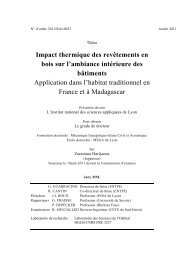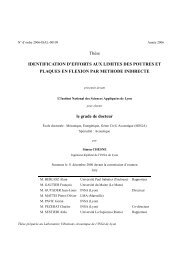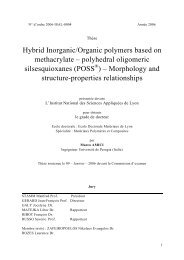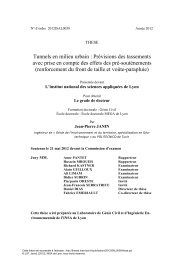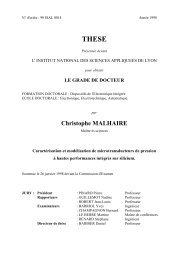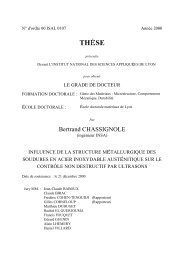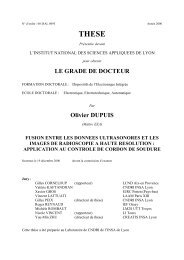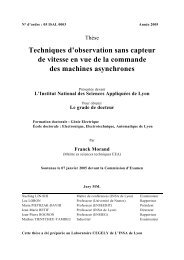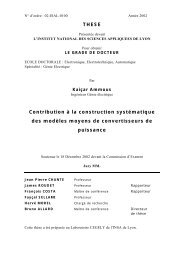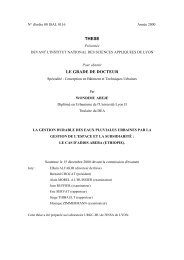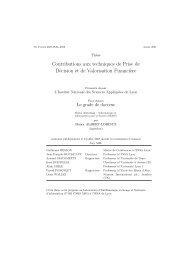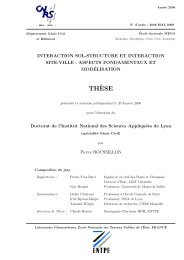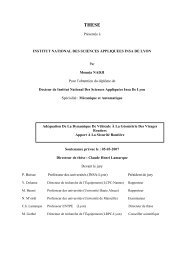- Page 1: N° d’ordre 2011ISAL0018 Année 2
- Page 5 and 6: Remerciements Je voudrais d’abord
- Page 7: Traitement et analyse de séries ch
- Page 13 and 14: Tables des matières INTRODUCTION G
- Page 15 and 16: Tables des matières 5.4.3 Avantage
- Page 17 and 18: Tables des matières CHAPITRE 12 :
- Page 19: Tables des matières 17.4.1 Conclus
- Page 23 and 24: Liste des variables Liste des varia
- Page 25 and 26: Liste des variables Ms ent Ms ini M
- Page 27: Liste des variables ρ e masse volu
- Page 31 and 32: Introduction générale Contexte g
- Page 33 and 34: Introduction générale Cette thès
- Page 35: Partie 1 La modélisation de la qua
- Page 39 and 40: Partie 1 - Chapitre 1 : Introductio
- Page 41 and 42: Partie 1 - Chapitre 1 : Introductio
- Page 43: Partie 1 - Chapitre 1 : Introductio
- Page 46 and 47: Partie 1 - Chapitre 2 : Approches d
- Page 48 and 49: Partie 1 - Chapitre 2 : Approches d
- Page 50 and 51: Partie 1 - Chapitre 2 : Approches d
- Page 52 and 53: Partie 1 - Chapitre 2 : Approches d
- Page 54 and 55: Partie 1 - Chapitre 2 : Approches d
- Page 56 and 57: Partie 1 - Chapitre 2 : Approches d
- Page 59 and 60:
Partie 1 - Chapitre 3 : Choix des a
- Page 61 and 62:
Partie 1 - Chapitre 3 : Choix des a
- Page 63:
Partie 1 - Chapitre 3 : Choix des a
- Page 67 and 68:
Partie 2 - Test des modèles et inc
- Page 69 and 70:
Partie 2 - Chapitre 4 : Le concept
- Page 71 and 72:
Partie 2 - Chapitre 4 : Le concept
- Page 73 and 74:
Partie 2 - Chapitre 4 : Le concept
- Page 75 and 76:
Partie 2 - Chapitre 4 : Le concept
- Page 77 and 78:
Partie 2 - Chapitre 4 : Le concept
- Page 79 and 80:
Partie 2 - Chapitre 4 : Le concept
- Page 81:
Partie 2 - Chapitre 4 : Le concept
- Page 84 and 85:
Partie 2 - Chapitre 5 : Les méthod
- Page 86 and 87:
Partie 2 - Chapitre 5 : Les méthod
- Page 88 and 89:
Partie 2 - Chapitre 5 : Les méthod
- Page 90 and 91:
Partie 2 - Chapitre 5 : Les méthod
- Page 92 and 93:
Partie 2 - Chapitre 5 : Les méthod
- Page 94 and 95:
Partie 2 - Chapitre 5 : Les méthod
- Page 96 and 97:
Partie 2 - Chapitre 5 : Les méthod
- Page 98 and 99:
Partie 2 - Chapitre 5 : Les méthod
- Page 100 and 101:
Partie 2 - Chapitre 5 : Les méthod
- Page 102 and 103:
Partie 2 - Chapitre 5 : Les méthod
- Page 104 and 105:
Partie 2 - Chapitre 5 : Les méthod
- Page 106 and 107:
Partie 2 - Chapitre 5 : Les méthod
- Page 108 and 109:
Partie 2 - Chapitre 5 : Les méthod
- Page 110 and 111:
Partie 2 - Chapitre 5 : Les méthod
- Page 112 and 113:
Partie 2 - Chapitre 5 : Les méthod
- Page 114 and 115:
Partie 2 - Chapitre 5 : Les méthod
- Page 116 and 117:
Partie 2 - Chapitre 5 : Les méthod
- Page 118 and 119:
Partie 2 - Chapitre 6 : Test des mo
- Page 120 and 121:
Partie 2 - Chapitre 6 : Test des mo
- Page 122 and 123:
Partie 2 - Chapitre 6 : Test des mo
- Page 124 and 125:
Partie 2 - Chapitre 6 : Test des mo
- Page 126 and 127:
Partie 2 - Chapitre 6 : Test des mo
- Page 129:
Partie 2 - Chapitre 6 : Conclusion
- Page 133:
Partie 3 - Construction de la base
- Page 136 and 137:
Partie 3 - Chapitre 7 : Présentati
- Page 138 and 139:
Partie 3 - Chapitre 7 : Présentati
- Page 140 and 141:
Partie 3 - Chapitre 7 : Présentati
- Page 142 and 143:
Partie 3 - Chapitre 7 : Présentati
- Page 144 and 145:
Partie 3 - Chapitre 8 : Traitement
- Page 146 and 147:
Partie 3 - Chapitre 8 : Traitement
- Page 148 and 149:
Partie 3 - Chapitre 8 : Traitement
- Page 150 and 151:
Partie 3 - Chapitre 8 : Traitement
- Page 152 and 153:
Partie 3 - Chapitre 8 : Traitement
- Page 154 and 155:
Partie 3 - Chapitre 9 : Présentati
- Page 156 and 157:
Partie 3 - Chapitre 9 : Présentati
- Page 158 and 159:
Partie 3 - Chapitre 9 : Présentati
- Page 160 and 161:
Partie 3 - Chapitre 9 : Présentati
- Page 162 and 163:
Partie 3 - Chapitre 9 : Présentati
- Page 164 and 165:
Partie 3 - Chapitre 9 : Présentati
- Page 166 and 167:
Partie 3 - Chapitre 9 : Présentati
- Page 168 and 169:
Partie 3 - Chapitre 9 : Présentati
- Page 170 and 171:
Partie 3 - Chapitre 9 : Présentati
- Page 173:
Partie 4 Analyse des données 145
- Page 177 and 178:
Partie 4 - Chapitre 10 : Variabilit
- Page 179 and 180:
Partie 4 - Chapitre 10 : Variabilit
- Page 181 and 182:
Partie 4 - Chapitre 10 : Variabilit
- Page 183 and 184:
Partie 4 - Chapitre 10 : Variabilit
- Page 185 and 186:
Partie 4 - Chapitre 10 : Variabilit
- Page 187 and 188:
Partie 4 - Chapitre 10 : Variabilit
- Page 189 and 190:
Partie 4 - Chapitre 10 : Variabilit
- Page 191 and 192:
Partie 4 - Chapitre 11 : Estimation
- Page 193 and 194:
Partie 4 - Chapitre 11 : Estimation
- Page 195 and 196:
Partie 4 - Chapitre 11 : Estimation
- Page 197 and 198:
Partie 4 - Chapitre 11 : Estimation
- Page 199 and 200:
Partie 4 - Chapitre 11 : Estimation
- Page 201 and 202:
Partie 4 - Chapitre 11 : Estimation
- Page 203:
Partie 4 - Chapitre 11 : Estimation
- Page 206 and 207:
Partie 4 - Chapitre 12 : Variabilit
- Page 208 and 209:
Partie 4 - Chapitre 12 : Variabilit
- Page 210 and 211:
Partie 4 - Chapitre 12 : Variabilit
- Page 212 and 213:
Partie 4 - Chapitre 12 : Variabilit
- Page 214 and 215:
Partie 4 - Chapitre 12 : Variabilit
- Page 216 and 217:
Partie 4 - Chapitre 12 : Variabilit
- Page 218 and 219:
Partie 4 - Chapitre 12 : Variabilit
- Page 220 and 221:
Partie 4 - Chapitre 12 : Variabilit
- Page 222 and 223:
Partie 4 - Chapitre 12 : Variabilit
- Page 224 and 225:
Partie 4 - Chapitre 12 : Variabilit
- Page 226 and 227:
Partie 4 - Chapitre 12 : Variabilit
- Page 228 and 229:
Partie 4 - Chapitre 12 : Variabilit
- Page 230 and 231:
Partie 4 - Chapitre 12 : Variabilit
- Page 232 and 233:
Partie 4 - Chapitre 12 : Variabilit
- Page 234 and 235:
Partie 4 - Chapitre 12 : Variabilit
- Page 236 and 237:
Partie 4 - Chapitre 12 : Variabilit
- Page 238 and 239:
Partie 4 - Chapitre 12 : Variabilit
- Page 240 and 241:
Partie 4 - Analyse des données : C
- Page 243:
Partie 5 - Choix des modèles et m
- Page 246 and 247:
Partie 5 - Chapitre 13 : Modèles d
- Page 248 and 249:
Partie 5 - Chapitre 13 : Modèles d
- Page 250 and 251:
Partie 5 - Chapitre 13 : Modèles d
- Page 252 and 253:
Partie 5 - Chapitre 13 : Modèles d
- Page 254 and 255:
Partie 5 - Chapitre 13 : Modèles d
- Page 256 and 257:
Partie 5 - Chapitre 13 : Modèles d
- Page 258 and 259:
Partie 5 - Chapitre 13 : Modèles d
- Page 261 and 262:
Partie 5 - Chapitre 14 : Modèles d
- Page 263 and 264:
Partie 5 - Chapitre 14 : Modèles d
- Page 265 and 266:
Partie 5 - Chapitre 14 : Modèles d
- Page 267 and 268:
Partie 5 - Chapitre 14 : Modèles d
- Page 269 and 270:
Partie 5 - Chapitre 14 : Modèles d
- Page 271 and 272:
Partie 5 - Chapitre 14 : Modèles d
- Page 273 and 274:
Partie 5 - Chapitre 14 : Modèles d
- Page 275 and 276:
Partie 5 - Chapitre 14 : Modèles d
- Page 277 and 278:
Partie 5 - Chapitre 14 : Modèles d
- Page 279 and 280:
Partie 5 - Chapitre 15 : Méthodolo
- Page 281 and 282:
Partie 5 - Chapitre 15 : Méthodolo
- Page 283 and 284:
Partie 5 - Chapitre 15 : Méthodolo
- Page 285 and 286:
Partie 5 - Chapitre 15 : Méthodolo
- Page 287 and 288:
Partie 5 - Chapitre 15 : Méthodolo
- Page 289:
Partie 6 Résultat des tests 261
- Page 293 and 294:
Partie 6 - Chapitre 16 : Test des m
- Page 295 and 296:
Partie 6 - Chapitre 16 : Test des m
- Page 297 and 298:
Partie 6 - Chapitre 16 : Test des m
- Page 299 and 300:
Partie 6 - Chapitre 16 : Test des m
- Page 301 and 302:
Partie 6 - Chapitre 16 : Test des m
- Page 303 and 304:
Partie 6 - Chapitre 16 : Test des m
- Page 305 and 306:
Partie 6 - Chapitre 16 : Test des m
- Page 307:
Partie 6 - Chapitre 16 : Test des m
- Page 310 and 311:
Partie 6 - Chapitre 17 : Test des m
- Page 312 and 313:
Partie 6 - Chapitre 17 : Test des m
- Page 314 and 315:
Partie 6 - Chapitre 17 : Test des m
- Page 316 and 317:
Partie 6 - Chapitre 17 : Test des m
- Page 318 and 319:
Partie 6 - Chapitre 17 : Test des m
- Page 320 and 321:
Partie 6 - Chapitre 17 : Test des m
- Page 322 and 323:
Partie 6 - Chapitre 17 : Test des m
- Page 324 and 325:
Partie 6 - Chapitre 17 : Test des m
- Page 326 and 327:
Partie 6 - Chapitre 17 : Test des m
- Page 328 and 329:
Partie 6 - Chapitre 17 : Test des m
- Page 330 and 331:
Partie 6 - Chapitre 17 : Test des m
- Page 332 and 333:
Partie 6 - Chapitre 17 : Test des m
- Page 334 and 335:
Partie 6 - Chapitre 17 : Test des m
- Page 336 and 337:
Partie 6 - Chapitre 17 : Test des m
- Page 338 and 339:
Partie 6 - Chapitre 17 : Test des m
- Page 341:
Conclusion générale 313
- Page 344 and 345:
Conclusion générale - Elaborer de
- Page 346 and 347:
Conclusion générale évidence la
- Page 348 and 349:
Conclusion générale l’utilisati
- Page 351 and 352:
Bibliographie Ackers P. et White W.
- Page 353 and 354:
Bibliographie (APUSS)". London (UK)
- Page 355 and 356:
Bibliographie CRCCH (2005). MUSIC (
- Page 357 and 358:
Bibliographie Freni G., Mannina G.
- Page 359 and 360:
Bibliographie ISO/CEI GUIDE 98-3/S1
- Page 361 and 362:
Bibliographie May D. et Sivakumar M
- Page 363 and 364:
Bibliographie Robert C. (2001). The
- Page 365 and 366:
Bibliographie Sutherland R.C. et Je
- Page 367:
Bibliographie Yang J., Reichert P.,
- Page 371 and 372:
Annexes Traitement de séries chron
- Page 373 and 374:
Annexes 1. ETALONNAGE DES CAPTEURS
- Page 375 and 376:
Annexes 2 ˆ 2 ˆ 2 u( x ) u ( X )
- Page 377 and 378:
Annexes 3. DÉTERMINATION DES FONCT
- Page 379 and 380:
Annexes suivant le critère 3, afin
- Page 381 and 382:
Annexes 1800 1600 DCO 1400 Masses
- Page 383 and 384:
Annexes MOURAD M., BERTRAND-KRAJEWS
- Page 385:
Annexes 2 2 2 ˆ 2 u( x ) u( b
- Page 388 and 389:
Annexes Secondly, the determination
- Page 390 and 391:
Annexes type and number of sensors
- Page 392 and 393:
Annexes Event load calculation In t
- Page 394 and 395:
Annexes Table 1. Pre-validation par
- Page 396 and 397:
Annexes In addition to the above Ch
- Page 398 and 399:
Annexes to monitoring and modelling
- Page 400 and 401:
Annexes the total storm event load
- Page 402 and 403:
Annexes Q or T fitting period t d s
- Page 404 and 405:
Annexes This trend is even more pro
- Page 406 and 407:
Annexes This confirms that the LPU
- Page 408 and 409:
Annexes CONCLUSION This work confir



